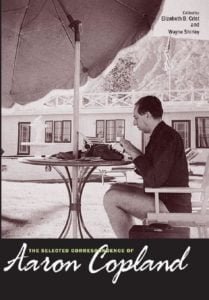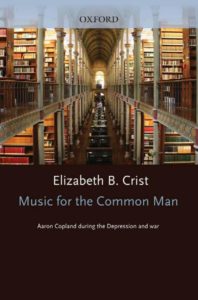Browse in the Library:
Copland: Clarinet Concerto (1947-1948) with sheet music

Aaron Copland, Clarinet Concerto
Aaron Copland devoted his life as a twentieth-century composer to fostering, developing, creating, and establishing distinctive “American” music. He became known as the “Dean of American Music,” a sobriquet with which he was uncomfortable. His name is synonymous with Appalachian Spring —the winner of the 1945 Pulitzer Prize in Music—and Fanfare for the Common Man.
Concerto for Clarinet and String Orchestra with Harp and Piano by Aaron Copland is a work dedicated to Benny Goodman, composed in 19491 and premiered on November 6, 1950, with Fritz Reiner conducting the NBC Studios Symphony Orchestra.

Benny Goodman commissioned a work from Béla Bartók in 1938 and another from Paul Hindemith in 1947, the same year he contacted Aaron Copland, who would never have thought of composing a clarinet concerto if Goodman had not commissioned one from him. Apart from arranging the Short Symphony in a sextet, where the clarinet is one of the protagonists, Copland’s only experience with the clarinet was in orchestral parts.
Copland was long a fan of Benny Goodman. Therefore, I was going to write the concerto with him in mind, and give him a fresh point of view. Copland and Goodman did not work together during the composition of the play, but when it was finished, he sent it to Goodman, who wrote back to thank him and said, ‘With a few minor corrections, I know we will have a good play.’
As they read the entire concerto, clarinetist David Oppenheim stood around them for moral support. Copland had written the last page too sharply, and had to lower the pitch range. Goodman made a few other suggestions, one of which concerned a high note in the cadence (Copland knew Benny could hit that note as he had heard it on his recordings), however he explained that while he could hit it comfortably when playing jazz for an audience, you might not be able to get it if you had to read it from sheet music or for a recording, so the note was changed.
Copland assumed that Goodman would plan a concert shortly after the work was finished, but almost a year later, he wrote on February 14, 1949: “I am terribly disappointed not to be able to perform the concert on May 10, but obviously with my current situation it would be silly of me to take such an important job at this time. I am looking forward to playing the concerto in public and will be putting a lot of work into it together with Ingolf Dahl in Los Angeles; meanwhile I will keep in touch with you until we find the right time to do it.”
Goodman made no demands on what Copland should write. He had complete freedom, with the condition that he should have a two-year exclusivity to perform the work. He performed the concerto repeatedly with Copland conducting, and two recordings were made. The first recording was for Columbia with the Columbia String Orchestra, but the second recording made in the 1960s is considered the best.
Best Sheet Music download from our Library.
The concerto lasts approximately sixteen and a half minutes and is made up of two movements connected by a cadenza. The first movement is a languid song composed in three-four time; and the second, a free form rondo, is a stark contrast in style, and jazzy in flavor.2
The cadence that unites the movements gives the soloist the opportunity to demonstrate his virtues, while at the same time introducing the fragments of melodic material that will be heard in the second movement; it is free within reason, after all, this and the following movement are in the language of jazz.
Some of the material in the second movement represents an unconscious fusion of elements obviously related to popular music from the USA and South America: Charleston rhythms, boogie-woogie, and the popular Brazilian airs. The Clarinet Concerto ends with a rather elaborate coda in C major that concludes with a glissando or “smear” in jazz jargon.
